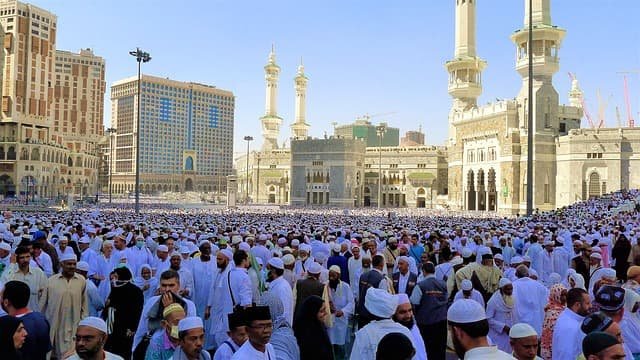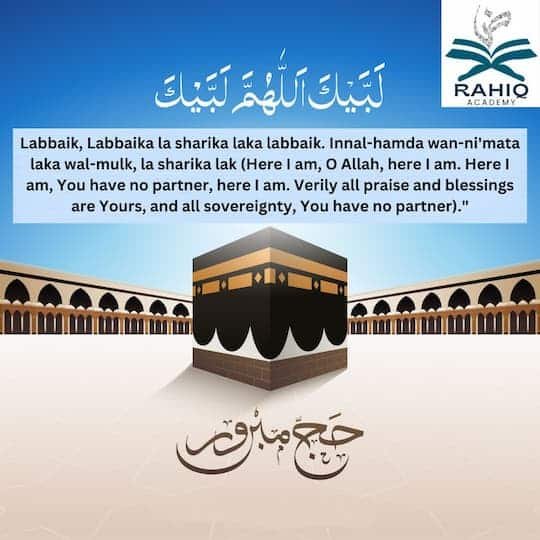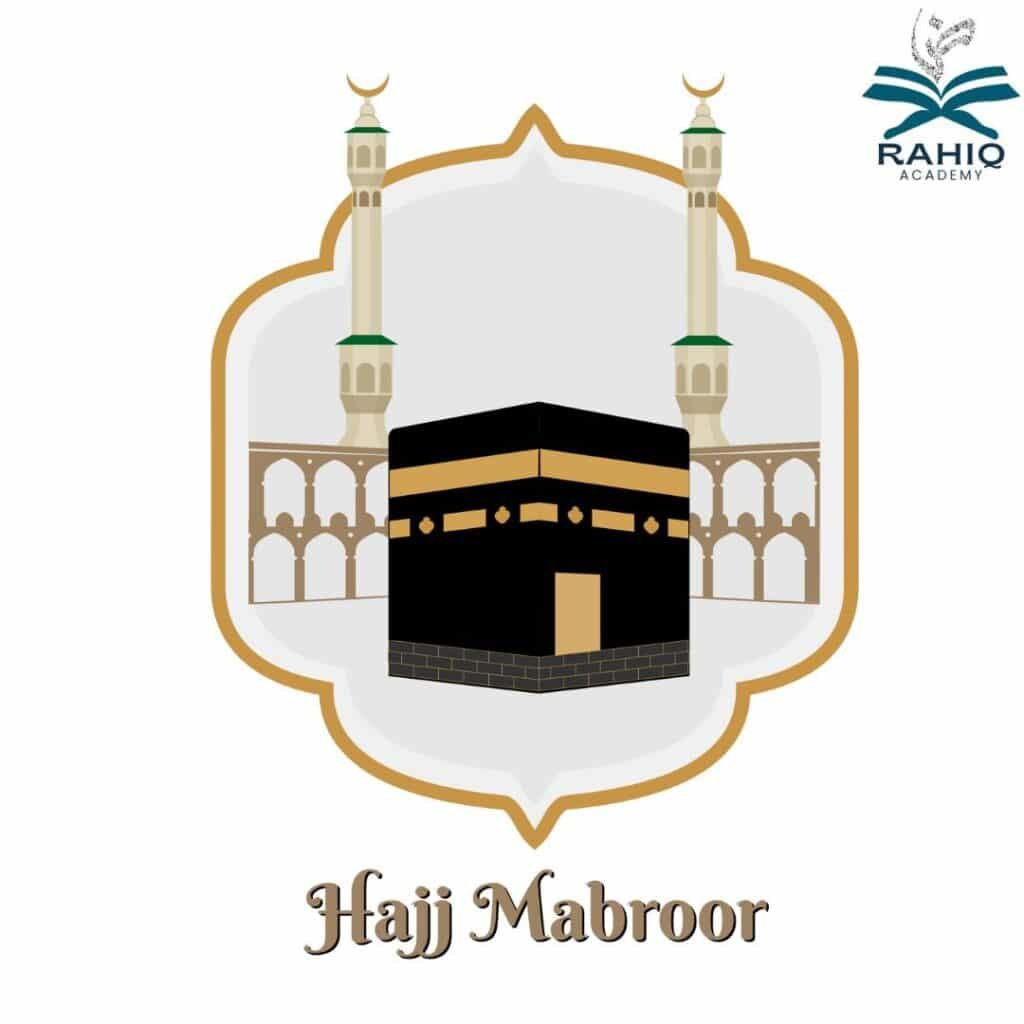Table of Contents
What is Hajj mabroor meaning?
Hajj is one of the Five Pillars of Islam and is a mandatory religious pilgrimage to Mecca in Saudi Arabia for Muslims who are physically and financially able to undertake it. Hajj mabroor meaning is to be accepted by allah
This pilgrimage must be performed at least once in a Muslim’s lifetime. Hajj takes place during the Islamic month of Dhul-Hijjah, from the 8th to the 12th day of the month.
Evidence from the Qur’an
(وَلِلَّهِ عَلَى النَّاسِ حِجُّ الْبَيْتِ مَنِ اسْتَطَاعَ إِلَيْهِ سَبِيلًا ۖ وَمَن كَفَرَ فَإِنَّ اللَّهَ غَنِيٌّ عَنِ الْعَالَمِينَ)
“And [due] to Allah from the people is a pilgrimage to the House – for whoever is able to find thereto a way. But whoever disbelieves – then indeed, Allah is free from need of the worlds.” (Surah Al-Imran, 3:97)
(وَأَذِّن فِي النَّاسِ بِالْحَجِّ يَأْتُوكَ رِجَالًا وَعَلَىٰ كُلِّ ضَامِرٍ يَأْتِينَ مِن كُلِّ فَجٍّ عَمِيقٍ)
“And proclaim to the people the Hajj [pilgrimage]; they will come to you on foot and on every lean camel; they will come from every distant pass.” (Surah Al-Hajj, 22:27).
Evidence from the Sunnah
عَنْ أَبِي هُرَيْرَةَ رَضِيَ اللَّهُ عَنْهُ قَالَ: قَالَ رَسُولُ اللَّهِ صَلَّى اللَّهُ عَلَيْهِ وَسَلَّمَ: “بُنِيَ الْإِسْلَامُ عَلَى خَمْسٍ: شَهَادَةِ أَنْ لَا إِلَهَ إِلَّا اللَّهُ وَأَنَّ مُحَمَّدًا رَسُولُ اللَّهِ، وَإِقَامِ الصَّلَاةِ، وَإِيتَاءِ الزَّكَاةِ، وَالْحَجِّ، وَصَوْمِ رَمَضَانَ”. (متفق عليه)
Abu Hurairah (may Allah be pleased with him) reported that the Messenger of Allah (peace be upon him) said, “Islam is built upon five pillars: testifying that there is no deity worthy of worship except Allah and that Muhammad is the Messenger of Allah, establishing the prayer, giving zakat, fasting Ramadan, and performing Hajj to the House (of Allah).” (Bukhari and Muslim)
عَنْ أَبِي هُرَيْرَةَ رَضِيَ اللَّهُ عَنْهُ قَالَ: قَالَ رَسُولُ اللَّهِ صَلَّى اللَّهُ عَلَيْهِ وَسَلَّمَ: “مَنْ حَجَّ لِلَّهِ فَلَمْ يَرْفُثْ وَلَمْ يَفْسُقْ رَجَعَ كَيَوْمِ وَلَدَتْهُ أُمُّهُ”. (متفق عليه)
Abu Hurairah (may Allah be pleased with him) reported that the Messenger of Allah (peace be upon him) said, “Whoever performs Hajj for the sake of Allah and does not commit any lewdness or sin, he will return as he was on the day his mother gave birth to him.” (Bukhari and Muslim)
The rituals of Hajj include entering a state of spiritual purity known as Ihram, performing Tawaf (circumambulating the Kaaba), walking between the hills of Safa and Marwah, standing vigil on the plains of Arafat, and participating in the symbolic stoning of the devil at Mina. The culmination of Hajj coincides with the Eid al-Adha, a major Islamic festival celebrated by Muslims worldwide, which commemorates the willingness of the Prophet Ibrahim (Abraham) to sacrifice his son in obedience to God’s command.
Hajj serves many purposes, including demonstrating the solidarity of the Muslim people and their submission to Allah. It is a deeply spiritual journey that renews a Muslim’s faith and sense of purpose in the world.
What are the Types of Hajj?
There are three types of Hajj that a Muslim can perform, each with slightly different rites and regulations:
1- Hajj al-Tamattu’
2-Hajj al-Qiran
3-Hajj Ifrad
What is Hajj Tamattu’?
Hajj Tamattu’ is a type of pilgrimage that combines Umrah and Hajj in the same journey. It allows the pilgrim to perform Umrah first during the months of Hajj (Shawwal, Dhul-Qa’dah, and Dhul-Hijjah), usually a few days before the Hajj begins.
After completing Umrah, the pilgrim exits the state of Ihram and can enjoy normal life until the 8th of Dhul-Hijjah.
On the 8th of Dhul-Hijjah, the pilgrim enters into a new state of Ihram with the intention of performing Hajj. The pilgrim then carries out all the rites of Hajj, such as going to Mina, Arafat, and Muzdalifah.
The key steps of Hajj Tamattu’ are:
-
- Enter Ihram at the Miqat with intention of Umrah and perform Umrah before Hajj starts.
- Exit Ihram after completing Umrah.
- On the 8th of Dhul-Hijjah, re-enter Ihram with intention of Hajj.
- Perform all the rites of Hajj
One of the conditions is that both Umrah and Hajj must be performed in the same year during the months of Hajj. An animal sacrifice is required for Hajj Tamattu’. This type of Hajj is commonly performed by pilgrims traveling from outside Makkah, as it provides more flexibility.
Evidence from the Sunnah
عَنِ ابْنِ عَبَّاسٍ رَضِيَ اللَّهُ عَنْهُمَا قَالَ: “مَتَّعَ رَسُولُ اللَّهِ صَلَّى اللَّهُ عَلَيْهِ وَسَلَّمَ فِي عُمْرَتِهِ إِلَى حَجَّتِهِ بِالْبَقَرِ وَالْبَدَنَةِ”. (متفق عليه)
Ibn Abbas (may Allah be pleased with him) reported: “The Messenger of Allah (peace be upon him) combined Umrah and Hajj (Hajj al-Tamattu’) with an offering of a cow and a camel.”
(Bukhari and Muslim)
What is Hajj Qarin?

Hajj Qiran is a type of pilgrimage where the pilgrim combines Umrah and Hajj under a single intention and state of Ihram. It is also known as the “accompanied Hajj.”
This type is especially beneficial for those coming from far away, as it allows them to perform both rituals in one journey.
The steps involved are:
-
- Enter Ihram at the Miqat with the intention of performing both Umrah and Hajj.
- Upon reaching Makkah, perform Tawaf al-Qudoom (arrival Tawaf) and Sa’i for Umrah rites.
- Do not shave/trim hair after Umrah. Remain in the same Ihram.
- Go to Mina, Arafat, Muzdalifah and perform all Hajj rites.
- Exit Ihram after stoning Jamarat al-Aqabah on Eid day.
For Hajj Qiran, it is obligatory to offer an animal sacrifice, unlike Hajj Ifrad where it is recommended but not obligatory.
The pilgrim stays in Ihram continuously from entering Ihram until the Day of Sacrifice, without a break.
Those living in Makkah cannot perform this type of Hajj.
Evidence from the Sunnah:
عَنْ عَائِشَةَ رَضِيَ اللَّهُ عَنْهَا قَالَتْ: “قَرَنْنَا مَعَ رَسُولِ اللَّهِ صَلَّى اللَّهُ عَلَيْهِ وَسَلَّمَ الْعُمْرَةَ وَالْحَجَّ”. (رواه البخاري)
Aishah (may Allah be pleased with her) said: “We combined Umrah and Hajj (Hajj al-Qiran) with the Messenger of Allah (peace be upon him).” (Bukhari)
What is Hajj Ifrad?
Hajj Ifrad is the simplest type of Hajj where the pilgrim performs only the rites of Hajj without combining it with Umrah. It is known as the “isolated Hajj.”
This type of Hajj is usually performed by residents of Makkah, areas within the Miqat boundaries, and those living in Jeddah.
The steps involved in Hajj Ifrad are:
-
- Enter into the state of Ihram at the Miqat with the sole intention of performing Hajj.
- Upon reaching Makkah, perform Tawaf al-Qudoom (arrival Tawaf).
- Perform Sa’i either immediately after Tawaf or delay it until after Tawaf az-Ziyarah later.
- Do not shave/trim hair, remain in Ihram until the Day of Sacrifice (Yawm an-Nahr).
- Go to Mina, Arafat, Muzdalifah and perform all the Hajj rites.
- Exit Ihram after stoning the Jamarat al-Aqabah on the Day of Sacrifice.
For Hajj Ifrad, offering an animal sacrifice is not obligatory, but it is recommended (Mustahabb).
If a pilgrim intending Ifrad ends up performing Umrah before Hajj, they are no longer considered a Mufrid and must switch to either Hajj Tamattu’ or Hajj Qiran.
Each type has specific merits and rules, but all fulfill the obligation of Hajj. The choice of which type to perform often depends on the pilgrim’s circumstances, arrival time in Mecca, and personal or legal preferences.
Which is the Best Type of Hajj to Perform?
There is no superior or inferior type of Pilgrimage in Islam. The variety that’s appropriate for you hinges on your location, the duration you have prior to the days of Pilgrimage, and your arrangements.
For instance, if you reside in the city of Jeddah and have only a day or two before the Pilgrimage commences, Hajj-ul-Ifraad may be an ideal choice for you. When you make an intention to perform Hajj-ul-Ifrad, you won’t be obligated to carry out the minor Pilgrimage and thus won’t risk arriving late for the Pilgrimage, the more crucial of the two rituals. However, if you do have a few days before the Pilgrimage begins, you can either perform Hajj Qarin or Hajj Tamattu’.
Conversely, if you dwell in another nation such as the UK, the only two options you possess include Hajj Qarin and Hajj Tamattu’.
So, how do you decide between the two?
It depends on when you plan to execute the minor Pilgrimage. If you’re arriving at the Sacred Mosque weeks before the Pilgrimage days, it’s optimal to make an intention of Hajj Tamattu’, so that you don’t have to comply with the restrictions imposed by the state of consecration during the extensive period between the minor Pilgrimage and the Pilgrimage. Most Muslims from around the world spend 4 to 5 weeks in Mecca, so they choose Hajj Tamattu’, rendering it the most commonly undertaken Pilgrimage type.
If, however, you plan to arrive at the Sacred Mosque a day or two before the Pilgrimage days, and you’re confident that you can adhere to the regulations of the state of consecration during the brief time between the minor Pilgrimage and the Pilgrimage, you can choose Hajj Qarin instead.
The Prophet Muhammad (peace be upon him) stated, “The prayer in my Mosque (the Prophet’s Mosque) is better than one thousand (1000) prayers in any other mosque with the exception of the Sacred Mosque, and a prayer in the Sacred Mosque is better than one hundred thousand (100,000) prayers.”
Bearing in mind the stringent penalties for violating the regulations of the state of consecration, it’s advisable not to take any risks. We recommend that you opt for Hajj-ul-Tamattu’ if you’re proceeding for the Pilgrimage from outside of Saudi Arabia.
What Are the Differences between Hajj and `Umrah?
After covering the various forms of Hajj extensively, we will now explore the distinctions between Hajj and Umrah.
The main differences between Hajj and Umrah are:
Obligation
-
- Hajj is one of the five pillars of Islam and is obligatory for every able-bodied and financially capable Muslim, to be performed at least once in a lifetime.
- Umrah is a Sunnah (recommended) act and not obligatory, though it holds great reward.
Time
-
- Hajj is performed during the specific days of the Islamic months of Dhul-Hijjah (8th to 13th).
- Umrah can be performed at any time of the year.
Rituals
-
- Hajj involves a sequence of rituals over several days, including staying at Arafat, Muzdalifah, stoning the Jamarat, and animal sacrifice.
- Umrah involves fewer rituals, primarily Tawaf (circumambulation) around the Kaaba and Sa’i (walking between Safa and Marwah).
Duration
-
- Hajj lasts for around 5-6 days.
- Umrah can be completed in a few hours.
Ihram

-
- During Hajj, pilgrims remain in the state of Ihram (a sacred state with certain restrictions) for several days.
- In Umrah, the state of Ihram is shorter, and pilgrims can exit it after completing the rituals.
Significance
-
- Hajj is considered the pinnacle of worship and a highly spiritual experience, as it commemorates the trials of Prophet Ibrahim (peace be upon him).
- Umrah is a highly recommended act of worship but does not hold the same level of significance as Hajj.
While both Hajj and Umrah involve visiting the Holy Mosque in Makkah and performing Tawaf and Sa’i, Hajj is a more extensive and intense spiritual journey with additional rituals and a specific time frame. Umrah can be seen as a smaller version of Hajj, but Hajj remains the ultimate obligation and goal for able Muslims.
What is the meaning of talbiyah in Islam
The Meaning of Talbiyah in Islam centers around complete submission to Allah. Recited by Hajj pilgrims, the phrase translates to “Here I am, at Your service, O Allah,” emphasizing Tawhid (oneness of God) and complete devotion during the pilgrimage. This continuous chant serves as a powerful reminder of their purpose and deepens their connection with the divine.
Talbiyah Dua

Complete Talbiyah Dua with translation
Arabic :
“لبيك اللهم ليبك، لبيك لا شريك لك لبيك ،أن الحمد والنعمة لك والملك لا شريك لك ”
Transliteration : “Labbaik, Labbaika la sharika laka labbaik. Innal-hamda wan-ni’mata laka wal-mulk, la sharika lak”
Translation : “Here I am, O Allah, here I am. Here I am, You have no partner, here I am. Verily all praise and blessings are Yours, and all sovereignty, You have no partner”
Concluding Remarks
Various Islamic traditions offer diverse views on the various forms of Hajj, along with their interpretations and advice regarding each. It is advisable to seek guidance from a scholar familiar with your specific tradition to determine the most suitable Hajj for you.
At Rahiq Academy, we offer an Online Islamic Course focused on the five pillars of Islam, with significant emphasis on Hajj. Feel free to reach out to our knowledgeable instructors for further insights into the different forms of Hajj and their associated practices.
Visit our Website to learn more, book Your Free Evaluation and enroll today.




